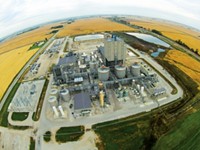Advertisement
Grab your lab coat. Let's get started
Welcome!
Welcome!
Create an account below to get 6 C&EN articles per month, receive newsletters and more - all free.
It seems this is your first time logging in online. Please enter the following information to continue.
As an ACS member you automatically get access to this site. All we need is few more details to create your reading experience.
Not you? Sign in with a different account.
Not you? Sign in with a different account.
ERROR 1
ERROR 1
ERROR 2
ERROR 2
ERROR 2
ERROR 2
ERROR 2
Password and Confirm password must match.
If you have an ACS member number, please enter it here so we can link this account to your membership. (optional)
ERROR 2
ACS values your privacy. By submitting your information, you are gaining access to C&EN and subscribing to our weekly newsletter. We use the information you provide to make your reading experience better, and we will never sell your data to third party members.
Business
Chemicals From Biorefineries
Alternative fuels and industrial chemicals from a single source are still a long way off
by Marc S. Reisch
October 12, 2009
| A version of this story appeared in
Volume 87, Issue 41

Genera Energy will open a pilot biorefinery later this year in Vonore, Tenn., that will produce ethanol from cellulosic materials. Along with optimizing the gathering, storage, and processing of switchgrass feedstock, maximizing the production of fuel from the facility will be the first order of business.
Sometime in the future, Genera will turn its attention to developing chemical co-streams at the 250,000-gal-per-year facility. When that will be is still unknown. “We’re optimistic we’ll be ready to copilot chemical streams in the not-too-distant future,” says Kelly Tiller, the firm’s chief executive officer.
Biorefineries that can produce fuel and chemicals from cellulosic biomass in the same way that an oil refinery produces such products from petroleum have been championed by governments and research groups for years now. But despite much R&D and millions of dollars in investment, the commercial reality of biorefining is still off on the horizon.
Set up by the University of Tennessee Research Foundation and underwritten with $41 million in state funding, Genera has the mission of building a demonstration biorefinery. A little more than a year ago, Genera formed a partnership with DuPont Danisco Cellulosic Ethanol (DDCE), a joint venture between DuPont and the Genencor enzyme division of Denmark’s Danisco. Genera is now using DDCE’s technology in its project to refine farm-raised switchgrass into fuels and chemicals.
DDCE’s genealogy would seem to make it the ideal partner to advance the biorefinery concept. DuPont has worked on biorefining at least as far back as 2002, when, along with partners including Danisco, it received an $18 million grant from the Department of Energy to develop a refinery that would produce ethanol, as well as propanediol and other chemicals.
DuPont also worked with DOE’s National Renewable Energy Laboratory to develop a fermentation organism, Zymomonas mobilis, that converts glucose and difficult-to-ferment xylose sugars from both starch and cellulose into ethanol. The fermentation organism is part of the design package DDCE brings to the Genera refinery.
But DDCE doesn’t see chemicals coming out of biorefineries any time soon. CEO Joseph P. Skurla tells C&EN that “our focus is on cellulosic ethanol.” The venture’s goal, he says, is to produce ethanol at a price that is competitive with traditional gasoline refined from $80-per-barrel petroleum. “That said, if we can create opportunities for chemicals from biomass, we’re interested in doing so,” he says.
Even DuPont’s chairman, Charles O. Holliday Jr., who has championed biotechnology at the firm, admits chemical production at biorefineries is a vision for the future. Speaking to reporters in July at a Biotechnology Industry Organization meeting where he received an award for innovation in industrial biotechnology, Holliday said DDCE “ultimately expects to develop chemicals,” but its focus now is on fuels development.
Timothy Rials, director of R&D in the office of bioenergy programs at UT Knoxville, is working with Genera on making chemicals at biorefineries, but nothing is close to commercialization. One promising project is the conversion of lignins into high-value carbon fibers that replace polyacrylonitrile-derived carbon fibers used in polymer composites. The lignins are left over after ethanol is extracted from biomass.
Rials notes that lignins are also a potentially valuable source of aromatic chemicals. “But we need to learn how to isolate and generate them,” he says. And some of the carbohydrate stream produced in a biorefinery could be diverted to make industrially useful C5 and C6 chemicals such as levulonic acid, aspartic acid, succinic acid, and furfural. “There is a lot of uncertainty about how these processes would operate within a biorefinery,” he acknowledges.
Other biofuel developers are also looking into the eventual development of chemical coproduct streams at biorefineries. Gevo, for instance, has licensed yeasts from Cargill and is genetically modifying them to express isobutanol. Patrick R. Gruber, Gevo’s CEO, envisions a cellulosic biorefinery with “chemistry units” that would upgrade the isobutanol into feedstocks for plastics such as polyethylene terephthalate and polymethyl methacrylate.
Gevo, which recently received an undisclosed investment from French oil and chemicals giant Total, just opened a pilot facility in St. Joseph, Mo., to demonstrate its technology. The biotech company has an alliance with engineering firm ICM for both the pilot plant and retrofitting existing corn ethanol plants to produce isobutanol.
Ambitious future plans aside, the development of an integrated fuel and chemical biorefinery is still in its infancy, cautions Peter Nieuwenhuizen, a principal at the consulting firm A. D. Little who follows industrial biotechnology. Biorefining will likely develop, he says, in a way that parallels the development of petroleum refining at the turn of the 20th century. Transportation fuels will come first, and then chemicals.
And, Nieuwenhuizen says, bioderived chemicals will come from three sources: direct production, biorefining, and expression in plants. Direct production is already a reality. For instance, DuPont and sugar producer Tate & Lyle make propanediol from corn-derived glucose. Likewise, Cargill converts glucose into polylactic acid for its Ingeo biopolymer. Chemical biorefineries, on the other hand, have barely reached the pilot stage, and chemicals expressed in genetically enhanced plants are furthest from commercialization, he says.
Nieuwenhuizen estimates the current size of the industrial biotechnology chemicals market at $70 billion to $100 billion, or 3–4% of global chemical sales. By 2025, if petroleum prices are high and bioderived fuels take off, he envisions the biotech chemicals market increasing about sevenfold and contributing about 17% of global chemical sales. That optimistic scenario still envisions petroleum as the source for most chemical production, he notes.
But, Nieuwenhuizen asks, what if people move to electric cars in large numbers? And what if the sun, wind, and coal provide the energy to power those vehicl.es? Then by 2025, biorefineries will hardly be necessary, he points out.
Demand for biotech-derived chemicals would still grow, but at a slower pace. Oil prices would likely be lower because of the diminished demand for transportation fuels. And between directly produced industrial biochemicals and chemicals expressed in green plants, Nieuwenhuizen forecasts biotech chemicals contributing around 12% of global chemical sales.
“Crude oil is a very convenient starting material for the chemical industry,” Nieuwenhuizen says. And even under the most optimistic scenario, he notes, “with a large installed petrochemical asset base, I see no fundamental reason why industrial biotechnology would completely take over petrochemical industry sales.”




Join the conversation
Contact the reporter
Submit a Letter to the Editor for publication
Engage with us on Twitter